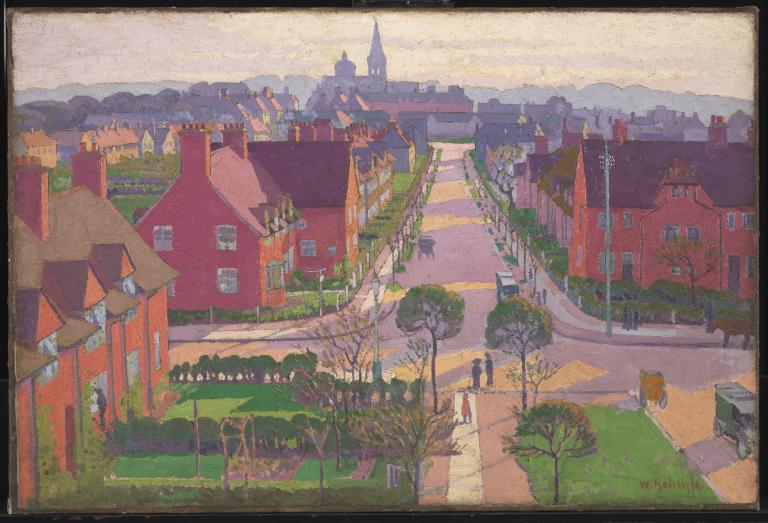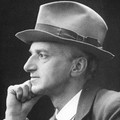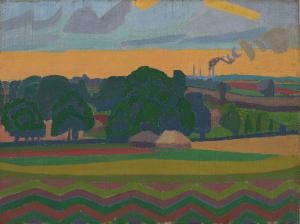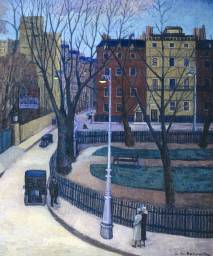William Ratcliffe Hampstead Garden Suburb from Willifield Way c.1914
© The estate of William Ratcliffe
William Ratcliffe,
Hampstead Garden Suburb from Willifield Way
c.1914
© The estate of William Ratcliffe
This painting shows the view from the Club House tower down Willifield Way in Hampstead Garden Suburb. Brilliant colours in the foreground recede into mauves, blues and grey violet waves in the distance, where a church steeple rises above the neighbouring roofs. In its harmonious composition, Ratcliffe’s painting emphasises the ideals of the Garden Suburb in uniting the benefits of town and country living.
William Ratcliffe 1870–1955
Hampstead Garden Suburb from Willifield Way
c.1914
Oil paint on canvas
510 x 763 mm
Inscribed ‘W. Ratcliffe’ bottom right
Presented by Tate Members 2006
T12260
c.1914
Oil paint on canvas
510 x 763 mm
Inscribed ‘W. Ratcliffe’ bottom right
Presented by Tate Members 2006
T12260
Ownership history
Inherited from the artist in 1955 by Samuel Kerkham [S.K.] Ratcliffe (1868–1958), the artist’s brother; given by the artist’s executors to the Hampstead Garden Suburb Institute, London, 1956, by whom sold to Tate 2006.
Exhibition history
1914
First Exhibition of Work by Members of the London Group, Goupil Gallery, London, March 1914 (103, as ‘From the Club Tower – Garden Suburb’, £15).
1946
Pastels and Drawings by Josef Herman. Oil Paintings by William Ratcliffe, Roland, Browse and Delbanco, London, September 1946 (37, as ‘Hampstead Garden Suburb’).
1951
The Camden Town Group, Southampton Art Gallery, June–July 1951 (107, as ‘Hampstead Garden Suburb’).
1954
An Exhibition of Paintings by William Ratcliffe, Letchworth Museum and Art Gallery, August 1954 (25, as ‘Hampstead Garden Suburb’, 50 guineas).
1996
La Ville moderne en Europe: Visions urbaines d’artistes et d’architectes 1870–1996, Museum of Contemporary Art, Tokyo, July–September 1996 (76, as ‘Hampstead Garden suburb seen from Willifield Way’, reproduced).
2002
Harold Gilman and William Ratcliffe, Southampton City Art Gallery, April–July 2002 (no catalogue number).
2003
Garden City into Camden Town: The Art of William Ratcliffe, Letchworth Museum and Art Gallery, September–October 2003 (56, as ‘Hampstead Garden Suburb’).
2004–5
Art of the Garden: The Garden in British Art, 1800 to the Present Day, Tate Britain, London, June–August 2004, Ulster Museum, Belfast, October 2004–February 2005, Manchester Art Gallery, March–May 2005 (13, reproduced).
2008
Modern Painters: The Camden Town Group, Tate Britain, London, February–May 2008 (79, reproduced).
References
1979
Wendy Baron, The Camden Town Group, London 1979, p.336.
Technique and condition
Hampstead Garden Suburb from Willifield Way is painted in artists’ oil colours on one piece of a plain and tightly woven canvas. Selvedges run along both vertical sides. The painting was lined with polyester sailcloth in a previous intervention and is stretched over a 2 cm thick marine plywood panel, attached with copper tacks.
The off-white ground seems to be applied by the artist himself: the ground does not extend onto the tacking margins along the bottom edge. Both the priming and initial drawing are only visible in a few gaps between adjacent shapes. In some areas, although observed with difficulty through the yellowed varnish, there appears to be a transparent light green wash on the priming that could have functioned as underpainting. Following the initial drawing, Ratcliffe has outlined his composition in violet paint.
The oil paint is applied thickly and opaquely, brushed on within the predetermined forms separated by ridges of paint at the boundaries between the forms. The malleable paint used for architectural features retains the short and linear brushstrokes whereas the green areas of the grass and the trees are more spiky and lively. The layering of the paint is clearly visible. Later added elements of the composition retain the spiky structure of the earlier dried layer as can be seen on the right-hand violet figure in the foreground, whereas the violet figure on the left was applied directly onto the ground. The colour scheme is dominated by contrasts of green with violet, pink and orange, which is disturbed by the light brown roof nearest to the viewer on the left. Between the gaps of brushstrokes glimpses of the previously laid-in bright green colour can be seen. It is likely that the varnish was applied later.
Simone Wernitznig
March 2010
How to cite
Simone Wernitznig, 'Technique and Condition', March 2010, in Helena Bonett, ‘Hampstead Garden Suburb from Willifield Way c.1914 by William Ratcliffe’, catalogue entry, January 2011, in Helena Bonett, Ysanne Holt, Jennifer Mundy (eds.), The Camden Town Group in Context, Tate Research Publication, May 2012, https://wwwEntry
Description
Painted from a high vantage point, this work shows the view south-east along Willifield Way in the newly built Hampstead Garden Suburb in London. The fronts of the houses on the left of the painting are brightly lit, while long purple shadows from the houses on the right are cast on to the road, suggesting that the time of day is late afternoon. The angle of the sun and the amount of tree foliage suggests that the time of year is spring.
Adopting the bright complementary colours used by other members of the Camden Town Group and post-impressionist painters, Ratcliffe has juxtaposed bright red and green as well as purple and yellow to create strong contrasts. Small figures populate the pavement on the right that leads to a horse, its carriage just out of sight, on the edge of the painting. In contrast to this outmoded form of transport, three motor cars are being driven along the spacious road.
At the centre of the composition to the front stand three larger figures. Two appear in dark purple silhouette while a third, a child in red coat and hat, stands out against a white path. The path, figures and straight road draw the viewer’s eye up the composition. A strong perspective is created by the road as it recedes into the distance, with the undulating treetops of Hampstead Heath articulated in a soft purple in the background, thus creating a sense of depth.
In contrast to the symmetrical Palladian style of much London architecture, the architects of the Suburb were inspired by the Arts and Crafts ideals of organic architectural forms. The houses depicted are a mixture of shapes and sizes, with plenty of healthy surrounding vegetation, creating the sense of a naturally evolving community; but the geometric lines marking out the houses, roads and gardens also give a sense of order. In this way, Ratcliffe’s painting reaffirms Hampstead Garden Suburb’s attempt to fuse the ideals of town and country living. The Times commented in 1909 that ‘The Garden Suburb at Hampstead is a proof of what can be done when order and design take the place of anarchy and chaos.’1
Hampstead Garden Suburb
Hampstead Garden Suburb was founded in 1907 by the social reformer and philanthropist Henrietta Barnett (1851–1936).4 The principal architects were partners Raymond Unwin (1863–1940) and Barry Parker (1867–1947), who had recently planned Letchworth Garden City. Willifield Way was designed by Parker and Unwin, Geoffry Lucas (1872–1947) and C.M. Crickmer (1879–1971). The buildings in the background of Ratcliffe’s painting, with the dome of the Free Church and the spire of St Jude’s among them, were part of the new development around Central Square designed predominantly by Edwin Lutyens (1869–1944).
In 1909, after three hundred houses had been built, Unwin and M.H. Baillie Scott (1865–1945) published a book on the achievements of the Suburb. For Unwin:
Too often, where lately were ‘Billowy bays of grass, ever rolling in shadow and sunshine,’ and quiet villages, which had slowly fitted themselves to hill and dale and wide expanse, files of hard-featured villas have entrenched themselves, and meaner dwellings of lamentable patterns have multiplied in rows.5
In contrast, ‘The Hampstead Garden Suburb is an attempt to unite modern standards of comfort and hygiene with old-world standards of proportion and refinement, to bring together the best that the English village and the English city have to give.’6 Hampstead Garden Suburb thus confirmed the ideals of the planner of Letchworth Garden City, Ebenezer Howard (1850–1928), as described in his Garden Cities of To-morrow (1898 and 1902). In a letter to Barnett in 1911, Unwin described the success of the Suburb:
The Garden Suburb has at least led the way in showing how thousands of people of all classes of society, of all sorts of opinion, of all standards of income, can live in helpful neighbourliness ... The scheme is founded on an ethical basis, and has as its aim the development of human understanding, whereby spiritual forces are given freedom.7
The Club House, designed by Parker and Unwin with detailing by Charles Paget Wade (1883–1956), opened in February 1909, and was the social centre of the Suburb. With nominally priced membership at 2d a week, the aim was to encourage residents from various social classes to mix. The facilities included tennis courts, a croquet lawn, bowling green, gymnasium and billiard tables as well as a smoking lounge with newspapers and periodicals, reading room and a library with over two thousand books, and halls and rooms for lectures, classes, concerts, dances, whist drives and meetings.8 Societies such as the Horticultural Society, the Suburb Parliament and the Quakers used the Club House for their gatherings.9
The part of the building that housed the tower where Ratcliffe’s painting was made jutted out into the walkway, facing down Willifield Way.10 An early photograph taken from the tower shows almost precisely the same view and composition to Ratcliffe’s work, except being slightly to the right.11 Indeed Ratcliffe may well have used this photograph, which was printed as a postcard before 1914, as a reference for his painting. The Club House was bombed during the Second World War on 25 September 1940;12 in its place now is the smaller Fellowship House, where the Garden Suburb Gallery is housed.
The Camden Town Group and the Garden Cities
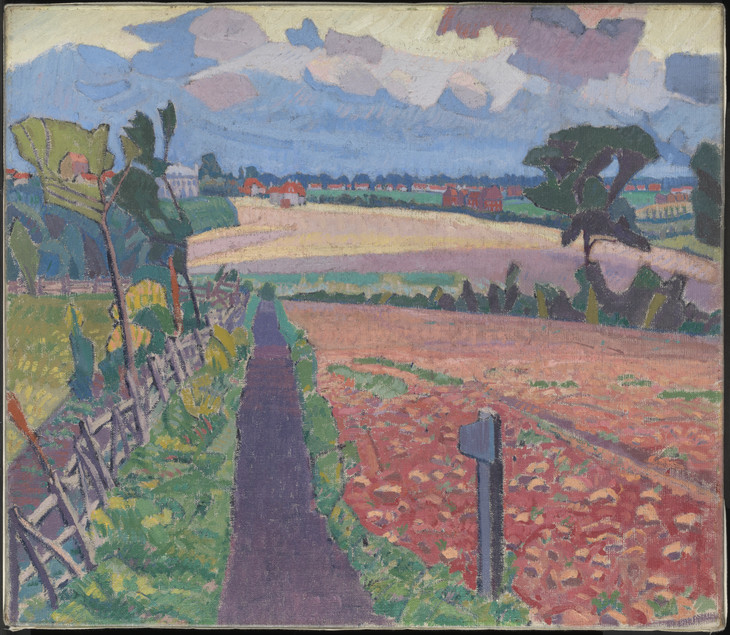
Spencer Gore 1878–1914
The Cinder Path 1912
Oil paint on canvas
support: 686 x 787 mm; frame: 815 x 924 x 73 mm
Tate T01960
Purchased 1975
Fig.1
Spencer Gore
The Cinder Path 1912
Tate T01960
Letchworth is located forty-four miles outside London, however, while Hampstead Garden Suburb is part of the city. Gore and other Camden Town Group members, such as Gilman and Charles Ginner, often sought out elements of the countryside within the city, frequently finding them in the gardens of London, as seen in Gore’s Mornington Crescent 1911 (Tate N05099), Ginner’s Victoria Embankment Gardens 1912 (Tate T03841) and Gilman’s Clarence Gardens N.W. c.1912 (Ferens Art Gallery, Hull).13 Ratcliffe likewise sought out gardens in his few depictions of the centre of London, as in Clarence Gardens 1912 (Tate T03359). As the art historian Ysanne Holt has argued, depictions of gardens by members of the Camden Town Group ‘suggest an idea of nature as pure, tame and unintimidating’, as ‘The London park ... resists the chaos of modernity’.14 In this way, Ratcliffe’s composition presents the ideals of the Garden City and Garden Suburb movement in its unification of the beauties of nature with the orderliness of civilised society.
Exhibition and ownership
Having been a member of the Camden Town Group, Ratcliffe automatically became a member of the London Group when it was formed towards the end of 1913. Hampstead Garden Suburb was shown at the first exhibition in March 1914 with the title From the Club Tower – Garden Suburb, along with Sundsholm Smaland, Sweden (7, £15), Still Life (10, £8), In the Garden Suburb (25, £10) and Sunshine (102, £10). Priced at £15, Hampstead Garden Suburb was one of the largest paintings Ratcliffe produced in his career, but it failed to secure a buyer.
Ratcliffe’s work continued to appear in group exhibitions over the decades, but he did not have his own show until 1946, when this painting was again displayed. A year before his death, in 1954 he held an exhibition at Letchworth Museum and Art Gallery. A rare photograph of the artist shows him hanging works for this display, including Hampstead Garden Suburb.15 Following his death in 1955, the painting was inherited by his brother, who the following year gave it to the Hampstead Garden Suburb Institute. From 1991 the work was on long loan to the Tate Gallery from the Institute, and was eventually acquired for the collection in 2006.
Helena Bonett
January 2011
Notes
Times, 7 February 1909; quoted in Raymond Unwin and M.H. Baillie Scott, Town Planning and Modern Architecture at the Hampstead Garden Suburb, London 1909, [before p.1].
List of Ratcliffe’s various addresses in Garden City to Camden Town: The Art of William Ratcliffe, exhibition catalogue, Letchworth Museum and Art Gallery 2003, [p.16].
Three photographs of Willifield Way just after it was built are reproduced in Unwin and Baillie Scott 1909, pp.77–8.
Barnett’s views were initially outlined in Henrietta Barnett, ‘A Garden Suburb at Hampstead’, Contemporary Review, vol.87, February 1905, pp.231–7.
Raymond Unwin, letter to Henrietta Barnett, 1911; quoted in Ruth Gilchrist and Tony Jeffs (eds.), Settlements, Social Change & Community Action: Good Neighbours, London and Philadelphia 2001, p.188.
Kathleen M. Slack, Henrietta’s Dream: A Chronicle of the Hampstead Garden Suburb 1905–1982, London 1982, p.68.
Mervyn Miller, Hampstead Garden Suburb: Arts and Crafts Utopia?, second edn, Chichester 2006, p.184. See, also, Hampstead Garden Suburb Residents’ Association, Illustrated History of Hampstead Garden Suburb, London 1954, p.17.
A pre-1914 photograph of the Club House showing the building with its landmark tower is reproduced in Mervyn Miller, Hampstead Garden Suburb: Past and Present, Chalford, Stroud 1995, p.61.
Related biographies
Related catalogue entries
How to cite
Helena Bonett, ‘Hampstead Garden Suburb from Willifield Way c.1914 by William Ratcliffe’, catalogue entry, January 2011, in Helena Bonett, Ysanne Holt, Jennifer Mundy (eds.), The Camden Town Group in Context, Tate Research Publication, May 2012, https://www

